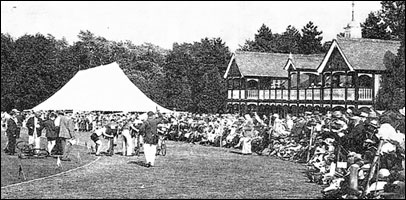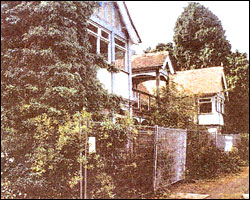![]()
The contents on this page remain on our website for informational purposes only.
Content on this page will not be reviewed or updated.
 |
|
 |
|
|
||||||
|
Bletchley Park Pavilion
|
||||||
|
||||||
|
IN present-day Bletchley, there is possibly no sight so sad as the forlorn and derelict condition of the former cricket pavilion of Bletchley Park. It is perhaps a blessing that such humiliation is now largely screened by some sort of 'fitness facility', which seems to have recently been plonked on the once superb playing field.
During Sir Herbert Leon's ownership of Bletchley Park, many county-class cricket matches were hosted on this ground, which also provided an ideal setting for the annual Bletchley Show. The story of Sir Herbert and his family belongs to another article, but suffice to say that, primarily as a London financier, he had amassed a fortune, which in 1883 enabled him to purchase Bletchley Park. Soon he began to make enlargements to the existing dwelling, and in 1896 plans were submitted to the council for a cricket pavilion. As well as being a picturesque backdrop to the annual Bletchley Show, by permission of Sir Herbert Leon the pavilion was often used by local organisations. One such occasion was a concert held by the local Railway Temperance Union. At the outbreak of the First World War, all entertainments and sports at Bletchley Park were cancelled and, with the country now facing more pressing needs, Sir Herbert Leon offered to lend the pavilion as a convalescent home for wounded soldiers. With a view towards providing garments for the anticipated inmates, in August 1914, Lady Leon presided at an afternoon meeting of ladies from the town and district, on the vicarage lawn. The offer of Miss F. Ridgway to act as under-nurse was accepted, and agreement was reached to help with making clothes for soldiers and sailors on foreign service and their dependents. Mrs Kirby was unanimously elected as secretary, and it was agreed to appoint a 'cutting out' committee, with any surplus clothing to be sent to central offices. A representative was appointed from each village, and it was proposed to make a house-to-house collection to raise funds. As a welcome bonus, Lady Leon announced she and Sir Herbert would equip the pavilion at their own expense. Providing convalescence was an obvious need, but also of national concern was accommodating the increasing influx of Belgian refugees, fleeing from German oppression. Lady Leon herself provided a home for a Belgian family - mother, father and five children -in one of her cottages on the Bletchley Park estate. When the man eventually found work (at the Diamond Iron Foundry) the family moved to London. Several Belgian families, however, remained in the district, including one at the pavilion. In early 1915, with the 'stability' afforded by the stalemate of the Western Front, two Belgian ladies accommodated at the pavilion would make a brief trip to Antwerp and return safely to Bletchley. Also more relaxed now were restrictions regarding the holding of sports events at Bletchley Park. This was due mainly to the need to provide recreational facilities for the troops now being stationed in the area. Thus one Saturday afternoon in May, the gates of Bletchley Park were opened to the public for a cricket match staged between the Regular Royal Engineers, based at Woburn Sands, and the Southern Army troops, (Signal Company), which had their headquarters in Bletchley. In late July, however, rain washed out an already postponed cricket match, which should have been played between an 11 drawn from the Signal Company RE (TF), now at Sandy, and a Bletchley XI. But due to advance sales of tickets, the sum of £1 17s 4d was still handed over to the Bucks Territorial Units Comforts Fund. In late August 1915 there would be a more poignant military presence when 50 wounded soldiers from Northampton General Hospital, and the Weston Home were driven to Bletchley Park for an afternoon outing. On arrival, the men, many of whom had lost limbs, were shown around the grounds, gardens and conservatories by head gardener Mr Cooper. Those who were unable to walk were entertained on the grass near the pavilion. Following an excellent tea served by the Bletchley Park household staff in the pavilion, the men were each presented with a packet of cigarettes by Master Richard Leon, grandson of Sir Herbert and Lady Leon. And from the gardens Mr Cooper had sent a choice buttonhole, not only for each of the men but, at their earnest request, also for their nurses at the hospital and home. The men were conveyed back to Northampton in cars, all of which had been lent by their owners. Established in December 1916, War Hospital Work For Women was being regularly undertaken at the pavilion in the Bletchley War Work Rooms, which were open every Wednesday from 10am to 5pm. The articles made would be sent to hospitals at home and abroad, and "Donations and gifts of old linen, wool and other materials will be gladly received by Lady Leon, Bletchley Park, or Mrs Stockley, Gable Cottage, Far Bletchley". On a typical day visitors would be able to see 32 energetic ladies busy at their work, as well as not only Lady Leon, industriously engaged at a sewing machine, but also Mrs Stockley, busy at her desk. In the centre of the large room, a board gave details of subscriptions received, gifts of materials and other donations. These included £1 4s - profits on the sale of cheese made in cheese-making classes at the Rectory. In November 1917, the committee thought it advisable to become affiliated to the British Red Cross Central Work Rooms, whose headquarters were in London. Following the end of the war, the work sessions finally closed on Wednesday, February 12, 1919. A total of 2,766 garments had been made, and it was proposed to send the balance of the funds, amounting to £4 7s 9d, to the Star and Garter hospital in Richmond, for the relief of totally disabled soldiers. With the end of the hostilities, Bletchley Park resumed its recreational roles, and after the death of her husband in 1926 Lady Leon continued the tradition. It was with her permission that the Bletchley Town Cricket Club, founded on February 16 1928, enjoyed the use of the Bletchley Park ground. Lady Leon died in 1936, and the entire Bletchley Park estate was put up for sale. Lot 3, the cricket ground and pavilion, was acquired by Bucks Education Department, and this was to soon prove opportune. For, with the influx of evacuees from London at the beginning of the Second World War, Mr E. C. Cook, headmaster of the Bletchley Road Senior School, received information that the Ecclesbourne Road Senior Boys' School, from Islington, would be accommodated in the Bletchley Park pavilion. Among the teaching staff was the headmaster, Mr S. Taylor. Although he qualified for retirement on the very same day, he had chosen to travel to Bletchley with the school, and subsequently became known to all the pupils as 'Dad'. He eventually retired in late August 1944 at the age of 65, and was presented with a cheque by the London teachers. His place was taken by Mr Jackson, another teacher who had originally travelled to Bletchley with the boys, and who had been teaching at the Yeomanry Hall since Easter. He retired at the closure of the London Senior Boys' School, in the pavilion, in February 1945 and the occasion was marked by the presentation of a cheque at a social gathering in the Spurgeon Memorial Baptist Church. Letters were read from both the former head, Mr Taylor, and a former colleague, Mr Michael, and on behalf of the children and parents a moving tribute was also paid by the headmistress of the Old Bletchley and Yeomanry Hall schools, Mrs Zilpah Bailey. The lessened number of pupils now attending the London Senior Boys' School were transferred to St Martin's Hall, with Mr W. Davies as the headmaster. The pavilion continued to play a useful role in the community. At the end of 1946 it would be used as a parcel depot, due to the volume of Christmas mail being sent. The central heating system broke down, but oil stoves were quickly brought in as an alternative. As for other uses, the Bletchley Town Silver Band was entered for a contest at Reading, on November 14 1947. Coached by Stanley Bonnington, of the famous Munn and Felton's Band, the members were granted the use of the Bletchley Park pavilion for one evening a week, at a cost of £3 per year. In 1956/57 Bletchley Grammar School was built, on land which had once formed a part of the Bletchley Park estate. During the building, the pavilion was employed for temporary classroom accommodation, and it was also used for sports and annual sports days. In 1964, with finance from county funds, the new North Bucks Music Centre was officially opened at the pavilion in late June by Sir Thomas Armstrong, president of the Royal Academy Of Music. One of only two such centres in the country, it was intended for use by North Bucks children, and adults in general. Yet nowadays there is no music to echo through the decayed architectural elegance, and to judge by the looming structural colossus that masks the previous grandeur, it might be said that, sadly, the building styles of the past seem to be quite literally overshadowed by the current idea of 'progress'. |
||||||
|
|
||||||
|
|
||||||


